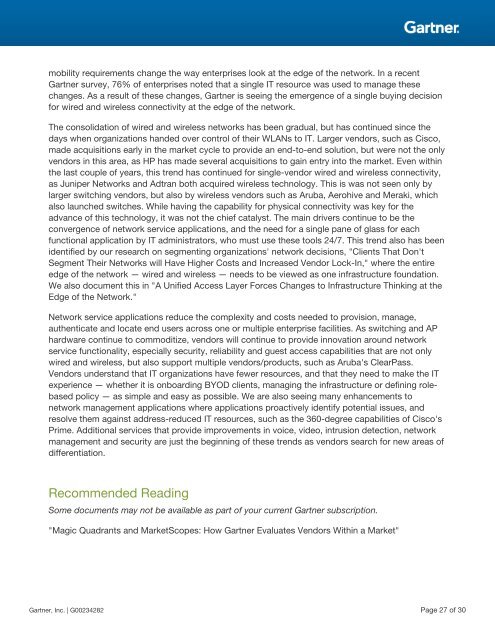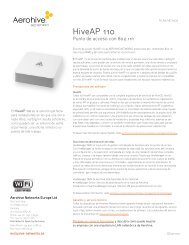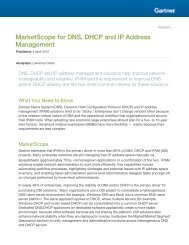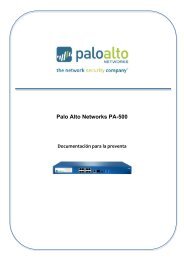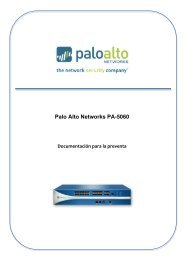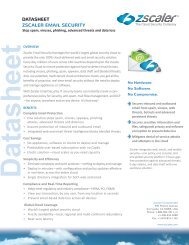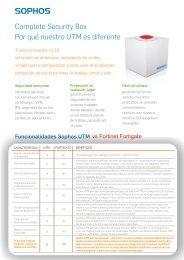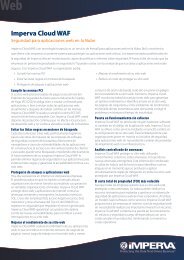Magic Quadrant for the Wired and Wireless LAN Access Infrastructure
Magic Quadrant for the Wired and Wireless LAN Access Infrastructure
Magic Quadrant for the Wired and Wireless LAN Access Infrastructure
- No tags were found...
You also want an ePaper? Increase the reach of your titles
YUMPU automatically turns print PDFs into web optimized ePapers that Google loves.
mobility requirements change <strong>the</strong> way enterprises look at <strong>the</strong> edge of <strong>the</strong> network. In a recentGartner survey, 76% of enterprises noted that a single IT resource was used to manage <strong>the</strong>sechanges. As a result of <strong>the</strong>se changes, Gartner is seeing <strong>the</strong> emergence of a single buying decision<strong>for</strong> wired <strong>and</strong> wireless connectivity at <strong>the</strong> edge of <strong>the</strong> network.The consolidation of wired <strong>and</strong> wireless networks has been gradual, but has continued since <strong>the</strong>days when organizations h<strong>and</strong>ed over control of <strong>the</strong>ir W<strong>LAN</strong>s to IT. Larger vendors, such as Cisco,made acquisitions early in <strong>the</strong> market cycle to provide an end-to-end solution, but were not <strong>the</strong> onlyvendors in this area, as HP has made several acquisitions to gain entry into <strong>the</strong> market. Even within<strong>the</strong> last couple of years, this trend has continued <strong>for</strong> single-vendor wired <strong>and</strong> wireless connectivity,as Juniper Networks <strong>and</strong> Adtran both acquired wireless technology. This is was not seen only bylarger switching vendors, but also by wireless vendors such as Aruba, Aerohive <strong>and</strong> Meraki, whichalso launched switches. While having <strong>the</strong> capability <strong>for</strong> physical connectivity was key <strong>for</strong> <strong>the</strong>advance of this technology, it was not <strong>the</strong> chief catalyst. The main drivers continue to be <strong>the</strong>convergence of network service applications, <strong>and</strong> <strong>the</strong> need <strong>for</strong> a single pane of glass <strong>for</strong> eachfunctional application by IT administrators, who must use <strong>the</strong>se tools 24/7. This trend also has beenidentified by our research on segmenting organizations' network decisions, "Clients That Don'tSegment Their Networks will Have Higher Costs <strong>and</strong> Increased Vendor Lock-In," where <strong>the</strong> entireedge of <strong>the</strong> network — wired <strong>and</strong> wireless — needs to be viewed as one infrastructure foundation.We also document this in "A Unified <strong>Access</strong> Layer Forces Changes to <strong>Infrastructure</strong> Thinking at <strong>the</strong>Edge of <strong>the</strong> Network."Network service applications reduce <strong>the</strong> complexity <strong>and</strong> costs needed to provision, manage,au<strong>the</strong>nticate <strong>and</strong> locate end users across one or multiple enterprise facilities. As switching <strong>and</strong> APhardware continue to commoditize, vendors will continue to provide innovation around networkservice functionality, especially security, reliability <strong>and</strong> guest access capabilities that are not onlywired <strong>and</strong> wireless, but also support multiple vendors/products, such as Aruba's ClearPass.Vendors underst<strong>and</strong> that IT organizations have fewer resources, <strong>and</strong> that <strong>the</strong>y need to make <strong>the</strong> ITexperience — whe<strong>the</strong>r it is onboarding BYOD clients, managing <strong>the</strong> infrastructure or defining rolebasedpolicy — as simple <strong>and</strong> easy as possible. We are also seeing many enhancements tonetwork management applications where applications proactively identify potential issues, <strong>and</strong>resolve <strong>the</strong>m against address-reduced IT resources, such as <strong>the</strong> 360-degree capabilities of Cisco'sPrime. Additional services that provide improvements in voice, video, intrusion detection, networkmanagement <strong>and</strong> security are just <strong>the</strong> beginning of <strong>the</strong>se trends as vendors search <strong>for</strong> new areas ofdifferentiation.Recommended ReadingSome documents may not be available as part of your current Gartner subscription."<strong>Magic</strong> <strong>Quadrant</strong>s <strong>and</strong> MarketScopes: How Gartner Evaluates Vendors Within a Market"Gartner, Inc. | G00234282 Page 27 of 30


